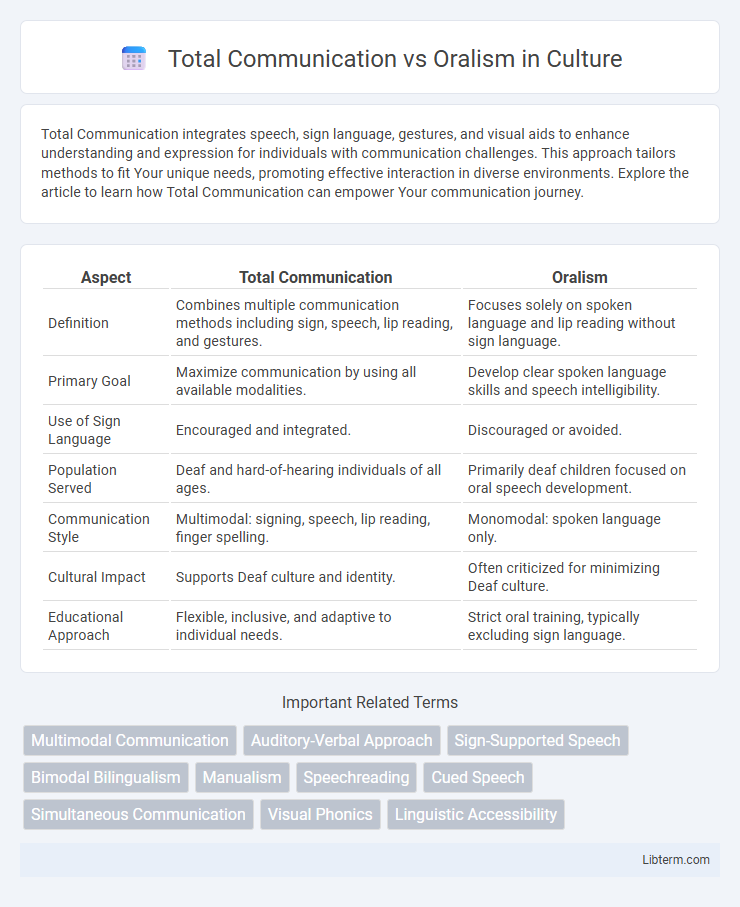Total Communication integrates speech, sign language, gestures, and visual aids to enhance understanding and expression for individuals with communication challenges. This approach tailors methods to fit Your unique needs, promoting effective interaction in diverse environments. Explore the article to learn how Total Communication can empower Your communication journey.
Table of Comparison
| Aspect | Total Communication | Oralism |
|---|---|---|
| Definition | Combines multiple communication methods including sign, speech, lip reading, and gestures. | Focuses solely on spoken language and lip reading without sign language. |
| Primary Goal | Maximize communication by using all available modalities. | Develop clear spoken language skills and speech intelligibility. |
| Use of Sign Language | Encouraged and integrated. | Discouraged or avoided. |
| Population Served | Deaf and hard-of-hearing individuals of all ages. | Primarily deaf children focused on oral speech development. |
| Communication Style | Multimodal: signing, speech, lip reading, finger spelling. | Monomodal: spoken language only. |
| Cultural Impact | Supports Deaf culture and identity. | Often criticized for minimizing Deaf culture. |
| Educational Approach | Flexible, inclusive, and adaptive to individual needs. | Strict oral training, typically excluding sign language. |
Introduction to Total Communication and Oralism
Total Communication integrates multiple modes of communication, including speech, sign language, and visual aids, to support language development in deaf and hard-of-hearing individuals. Oralism emphasizes spoken language and lip-reading while minimizing the use of sign language to promote verbal communication skills. These distinct approaches address the diverse needs of learners by prioritizing either a multimodal or speech-centric educational methodology.
Historical Background of Deaf Education
Total Communication emerged in the 1960s as a response to the limitations of Oralism, incorporating sign language, speech, lip reading, and other communication methods to enhance deaf education. Oralism, dominant from the late 19th century following the Milan Conference of 1880, emphasized teaching deaf individuals exclusively through spoken language, often suppressing sign language. The historical shift toward Total Communication marked a more inclusive approach, acknowledging the diverse needs of deaf learners and improving educational outcomes.
Philosophies Behind Total Communication
The philosophy behind Total Communication emphasizes using all available means of communication, including sign language, speech, gestures, and visual aids, to support language development and comprehension in deaf and hard-of-hearing individuals. This approach advocates for a flexible, multimodal strategy tailored to each individual's unique needs rather than enforcing speech-only methods. Total Communication fundamentally challenges Oralism's exclusive focus on spoken language by promoting inclusivity and maximizing expressive potential through a combination of communication forms.
Core Principles of Oralism
Oralism centers on teaching deaf individuals to develop spoken language skills through lip reading, speech training, and auditory cues, emphasizing integration into the hearing world. This approach relies on structured speech therapy and auditory discrimination to facilitate verbal communication, often minimizing the use of sign language. Core principles include prioritizing residual hearing, fostering articulation precision, and promoting speech as the primary mode of interaction to enhance social and educational outcomes.
Communication Methods and Techniques
Total Communication integrates multiple communication methods including speech, sign language, lip-reading, finger spelling, and use of visual aids to enhance understanding for individuals with hearing impairments. Oralism emphasizes spoken language through intensive speech therapy, auditory training, and lip-reading, prioritizing speech production and comprehension without reliance on sign language. Both approaches tailor techniques to individual needs, but Total Communication promotes a multimodal strategy, while Oralism focuses solely on auditory-verbal skills.
Advantages of Total Communication
Total Communication enhances language acquisition by combining speech, sign language, and visual aids, making communication accessible for diverse learning styles. It supports cognitive development and social integration by allowing children to use multiple modes of expression simultaneously. This approach fosters more inclusive education environments and improves overall comprehension and interaction for individuals with hearing impairments.
Benefits and Limitations of Oralism
Oralism emphasizes spoken language development using lip-reading, speech therapy, and auditory training, enabling many deaf individuals to integrate more easily into hearing communities and educational settings. However, limitations include potential delays in full language acquisition, dependence on residual hearing or hearing aids, and increased cognitive load due to reliance on visual cues and speech production. This approach may also restrict access to American Sign Language (ASL) or other sign languages, potentially limiting cultural identity and communication options.
Impact on Language Development
Total Communication integrates sign language, gestures, lip reading, and speech, promoting comprehensive language development by accommodating diverse communication preferences. Oralism centers solely on spoken language, often limiting expressive and receptive language skills in children who benefit from visual cues. Research indicates that Total Communication supports stronger cognitive and social growth by fostering bilingual language acquisition and reducing language delays.
Educational Outcomes and Academic Achievement
Total Communication integrates sign language, speech, lip reading, and finger spelling to support diverse learning needs, often resulting in enhanced comprehension and social interaction for deaf students. Oralism emphasizes spoken language and lip reading, which may limit access to information but can facilitate integration into mainstream educational settings. Studies reveal that students utilizing Total Communication often demonstrate higher academic achievement and more robust literacy skills compared to those relying solely on Oralism.
Choosing the Right Approach for Deaf Learners
Total Communication integrates sign language, speech, lip reading, and auditory training to cater to diverse learning needs of deaf learners, enhancing communication flexibility and cognitive development. Oralism emphasizes speech and lip reading, aiming to develop spoken language skills and facilitate integration into hearing communities. Selecting the appropriate approach depends on individual auditory abilities, cognitive preferences, family involvement, and educational goals, ensuring personalized and effective language acquisition.
Total Communication Infographic

 libterm.com
libterm.com